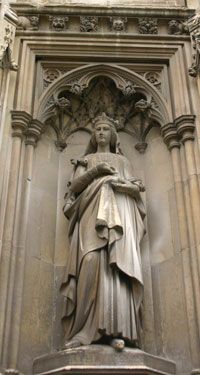Advent Day 12 - Canterbury Cathedral
Posted on
The first cathedral I ever set foot in was for my 28th birthday, the gentleman that I’d been dating for a few months (who’s now my fiancé) suggested that we visit somewhere as a birthday present. There was one place I’d wanted to visit for years, and happily he agreed to take me – Canterbury Cathedral!
Old Before the Normans
Canterbury was an old church even before the Normans arrived with a grand rebuilding plan. The first cathedral was founded in 597, after Augustine of Canterbury was sent to convert the Anglo Saxons by Pope Gregory I. The chronicler Bede recorded that the first cathedral was founded on the site of an earlier Roman church, but so far excavations haven’t found any evidence of this. Assuming the date of 597 is correct, a cathedral had still stood on that site for over 460 years before the Norman invasion.
The cathedral was damaged during a Viking raid in 1011, and burned down in 1067. The first Norman archbishop, Lanfranc, took the opportunity to rebuild in the style of his homeland. The new Canterbury Cathedral was designed along the same lines of Caen’s Abbey of St Etienne, Lanfranc’s former abbey and an institution founded by William the Conqueror in his pre-conquest years. Successive archbishops continued the building work, including a new crypt and choir, and several chapels.
Further expansion was needed after the murder of St Thomas Beckett. The veneration of the martyred archbishop led to a significant rise in pilgrim traffic, and income. The Trinity Chapel was built to house a shrine to St Thomas, his remains were relocated to the new shrine in 1220. Along with significant donations from wealthy nobles, both in England and abroad, smaller donations and purchases were made by pilgrims who travelled to the cathedral to pray at the shrine. As proof of their visit, they could buy little pilgrim badges made of cheap metal, which depicted the saint, or his shrine. It also became a Royal burial site, Prince Edward (The Black Prince) was buried in the Cathedral in 1376, although his wife Joan of Kent chose to be buried next to her first husband, Edward was her third. Henry IV, who died in 1413, chose to be buried in the Trinity Chapel raised to St Thomas, and his second wife Joan of Navarre was interred next to him in 1437.
It’s Still Standing! (Just About)
The abbey side of the cathedral was removed during the Dissolution of the Monasteries, but Canterbury’s tradition of being the seat of the main Archbishop in England remained. St Thomas’ shrine was also destroyed, and his remains were destroyed (possibly thrown in to the river). During Cromwell's time most of the stained glass windows were destroyed, and part of the building was used as a stable for horses.
In the following centuries more care was taken with the buildings. The north west tower was in a dangerous condition and had to be removed in the 1830s, but was replaced by a copy of the south west tower to keep the symmetry of the building. A fire in 1872 destroyed the roof of the Trinity Chapel, but the body of the chapel survived and the roof was quickly replaced. The Cathedral was was a target for German bombs during the Second World War, and although the cathedral's library was destroyed the Cathedral itself was relatively unscathed.
In recent years the Cathedral has been found in desperate need of repair, as the stained glass is corroding and the stonework is crumbling, while roof leaks were doing further damage. Work is currently being focused on the North West Transept, with a team of masons, conservators and carpenters, and several apprentices. Work is supported by donations to the Canterbury Cathedral Trust, and there's still lots to be done to ensure the cathedral can be kept openly safely for visitors. If you'd like to find out how to donate to the trust, click here!